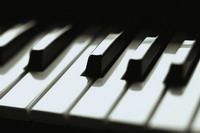Piano Sheets > Ray Charles Sheet Music > I Got A Woman (ver. 1) Piano Sheet
I Got A Woman (ver. 1) by Ray Charles - Piano Sheets and Free Sheet Music

About the Song
"I Got a Woman" is a song co-written and recorded by American R&B/soul musician Ray Charles and released as a single in December of 1954 on the Atlantic label as Atlantic 45-1050 b/w "Come Back Baby." Both sides later appeared on his 1957 album Ray Charles (or, Hallelujah I Love Her So).
Built on a gospel hymn, "Jesus Is All the World to Me", Ray was listening to on the radio while on the road with his band, he and his band member, trumpeter Renald Richard penned a song which was built among a gospel frenetic pace with secular lyrics and a jazz-inspired rhythm and blues background, the song would be one of the prototypes for what later became termed as "soul music" after Charles released "What'd I Say" nearly five years later.
The song was recorded late 1954 in an Atlanta studio and was Charles' first #1 R&B hit in January 1955. The song would lead to more hits for Charles during this period.
Download this sheet!
About the Artist

Random article
How to enhance sight-reading for piano sheet music If you want to learn how to play, the piano in a live performance impromptu then you need to improve your sight-reading of sheet music. Chances are you will have to play music notes, which are unfamiliar.
Picking it at random
One of the best ways to enhance your sight-reading of piano notes is to pick any book randomly and start playing. Ideally, you want to start playing these musical notes from the first page and continue until you reach the very end. The trick is to be stern with yourself and not stop playing until you reach the last page of the sheet music.
(More...)
